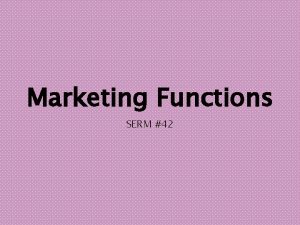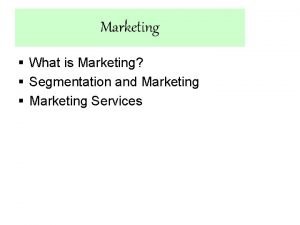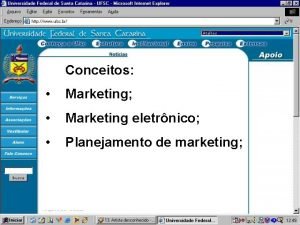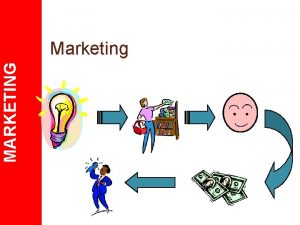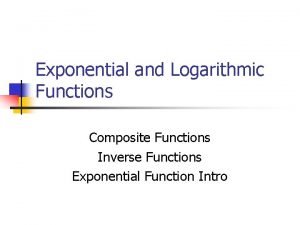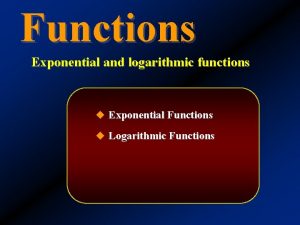Clark and Clark divided the marketing functions under
























- Slides: 24


Clark and Clark divided the marketing functions under three major groups-functions of exchange, functions of physical supply and facilitating functions. All the essential functions are included. It is an accepted classification. The Classification is shown above:

FUNCTIONS OF EXCHANGE Exchange brings about changes in the ownership of productions. In the process of changes transfer in the ownership, the two important functions are buying and selling are complementary to each other but not contradictory with a different view-point. For better understanding of the activities, this function is sub-divided into buying and assembling and selling.

Buying It is the first step of marketing functions. It is carried out by all marketers- the manufacturers, the wholesalers, the retailers etc. Buying and selling are inseparable. Both happen at the same time. For example, if any one buy a thing, then there should be someone to sells the product. The buying function is over, the buyer gets the title to the product. Buying may be done either directly or throught middlemen.


ASSEMBLING Assembling of goods the process of keeping the goods, purchased from different places, at the particular place. For example, retailers buy different commodities of different sized in different quantity, in different quality for their further movement. The main aim of assembling is to bring the procedure at a central place in order to disperse them either for production or consumption purpose.


SELLING The process of transferring ownership f goods from the seller to the buyer is what is known as selling. The primary objective of marketing is to sell the products at a profit. Sales are cocerned with the activities, whichconvert the desire into demand. Creation of demand its maintenance, expansion etc. In this modern period, with mass productions, stiff competitions in market etc. , the process of selling is a complicated functions.


Functions of physical supply The second group of marketing process is the physical supply. These are the functions that are related with creatio of place and time utilities. Physical transfer of goods from the manufacturer to consumer takes place by means of Transporation and storage.


TRANSPORTATION The goods produced in a particular place are not consumed there itself. From the place of production the goods need to be taken to the various consumption centers which are scattered throughout the country are even throughout the world. The good from a place where they are not needed, are transferred to place where they are needed. The function of transport can be as that of a nerve system, through which the blood circulates and keeps the body working at ease. Goods are sent to the markets through land, sea and air. The cost of transport is justified by the creation of place utility.


STORAGE A manufacturer needs to keep adequate stock of raw materials to ensure smooth production. A trader has to maintain adequate stock of the products he sells to meet the demand. Storage functions is necessary in concentration as well as in dispersion. The function is done by the manufacturers, wholesalers, and professional warehouse keepers. Marketers can easily adjust the supply with demand through warehousing and transportation.


FACILITATING FUNCTION The facilitating functions are FINANCING, RISK-BEARING, STANDARDISATION, MARKETING INFORMATION and PROMOTION. All these are supporting activities. But these activities contributes in carrying out other functions.


Financing Finance is the most fundamental aspect for any merchandise transactions. Funds are required to hold the stock and to meet the cost of marketing. Finance is needed for production as well as for marketing and production of finished goods. It means that the manufacturer who invests in raw materials has to wait till the consumers pay for the finished goods. The waiting period is undertaken by financial institutions by granting loans. Merchandising machines are lubricated constantly by such financial institutions. There are various kinds of finance needed- short term, medium term, long term etc. , and the source are commercial banks, co-operative credit societies, other agencies etc.

Risk Taking In marketing , there arise numerous damages to goods, Physical loss, changes in economic values of goods, mismanagement , credit losses etc, There are loss on account of fire, flood, deterioration, bad debts etc. On all these occasions, all intelligent businessman reduces the possibility of risks. Thus the risks are to be shouldered, shifted or reduced. Some of the risks are insurable, while others are not. Eg: loss on account of fire, accident etc. Can be insured with insurance companies. But the loss on account of fall in demand, prices, competitions etc. Risks due to natural calamities Physical risks Economics risks Risks due to technological development Political risks.

STANDARDISATION Standardization is related with the division of commodities into distinct groups. Standard is used in providing certain basic qualities to the goods for their use. Standard is a specification. It help mainly to know whether a product conforms to the expected quality and the price paid is justified Grading it refers to the process of agricultural goods, these will be variations between products of the same variety. The size, shape, colour and taste of two or more pieces of tomato or beetroot will not be the same. Buying and selling become easier.

Marketing Information The desired success of marketing depends on correct and timely decisions. These decisions are based on market information or market intelligence. Modern marketing must have information of size location, characteristics of markets etc. The customer’s wants, habits, purchasing power etc. , are to be considered, the strength or weakness of competitors, trend in market, supply and demand etc. are also to be taken into account.

PROMOTION Promotion is a wide term including advertising, personal selling, sales promotions etc. , Marketing communications are essential for both sellers and buyers. Sale promotions are marketing device to stimulate or restimulate demand for products. The behavior of buyers can favorably be influenced only through promotion. Promotional programmes are needed for both consumer goods and industrial goods. Persuasive communication or effective promotion will facilitate the marketers to increase and maintain their market share.

Conclusion The functions classified above provide a bird’s eye-view of the area of marketing. They provide a basic knowledge, before proceeding further for a deeper study. The selection of classification really depends on the necessity, circumstances of each case.

 Functions of marketing by clark and clark
Functions of marketing by clark and clark Hát kết hợp bộ gõ cơ thể
Hát kết hợp bộ gõ cơ thể Lp html
Lp html Bổ thể
Bổ thể Tỉ lệ cơ thể trẻ em
Tỉ lệ cơ thể trẻ em Gấu đi như thế nào
Gấu đi như thế nào Glasgow thang điểm
Glasgow thang điểm Chúa yêu trần thế alleluia
Chúa yêu trần thế alleluia Các môn thể thao bắt đầu bằng tiếng bóng
Các môn thể thao bắt đầu bằng tiếng bóng Thế nào là hệ số cao nhất
Thế nào là hệ số cao nhất Các châu lục và đại dương trên thế giới
Các châu lục và đại dương trên thế giới Cong thức tính động năng
Cong thức tính động năng Trời xanh đây là của chúng ta thể thơ
Trời xanh đây là của chúng ta thể thơ Mật thư tọa độ 5x5
Mật thư tọa độ 5x5 Làm thế nào để 102-1=99
Làm thế nào để 102-1=99 độ dài liên kết
độ dài liên kết Các châu lục và đại dương trên thế giới
Các châu lục và đại dương trên thế giới Thể thơ truyền thống
Thể thơ truyền thống Quá trình desamine hóa có thể tạo ra
Quá trình desamine hóa có thể tạo ra Một số thể thơ truyền thống
Một số thể thơ truyền thống Bàn tay mà dây bẩn
Bàn tay mà dây bẩn Vẽ hình chiếu vuông góc của vật thể sau
Vẽ hình chiếu vuông góc của vật thể sau Thế nào là sự mỏi cơ
Thế nào là sự mỏi cơ đặc điểm cơ thể của người tối cổ
đặc điểm cơ thể của người tối cổ Ví dụ về giọng cùng tên
Ví dụ về giọng cùng tên
































